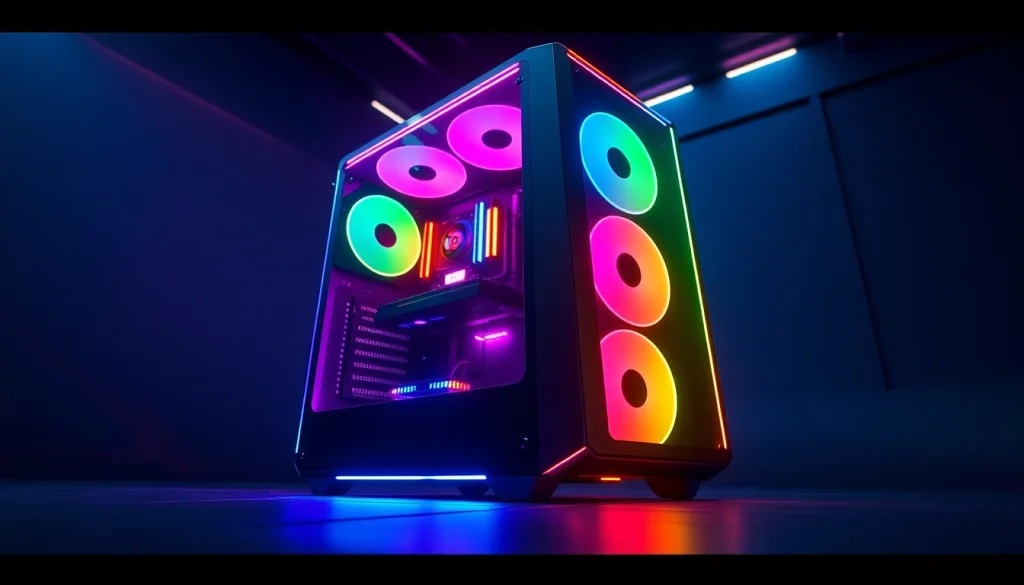
Understanding Custom Gaming PC Cases
What is a Custom Gaming PC Case?
A custom gaming pc case is a personalized enclosure designed to house your gaming components, including the motherboard, CPU, GPU, and storage devices. Unlike standard cases, custom gaming PC cases allow for unique designs, tailored dimensions, and specific functionalities that cater to individual preferences and performance needs. These cases can be crafted from various materials, feature aesthetic enhancements, and provide optimal airflow and cooling solutions.
Benefits of Customization
The customization of a gaming PC case offers numerous advantages, making it a popular choice among enthusiasts. Firstly, unique customization allows gamers to express personal style through color schemes, lighting configurations, and themed designs. This not only enhances visual appeal but also elevates the overall gaming experience.
Secondly, custom gaming PC cases can be engineered for enhanced functionality. Gamers can prioritize cooling solutions, ensuring optimal thermal performance during intense gaming sessions. Additionally, bespoke cable management systems can be integrated to maintain a clean and organized interior.
Lastly, customization opens the door to improved compatibility with specific components, making it easier to house high-performance gaming hardware while maintaining an efficient cooling system and aesthetic appeal.
Popular Styles and Configurations
As the gaming culture evolves, so do the designs of gaming PC cases. A few notable styles include:
- Mid Tower Cases: These are the most popular configurations, balancing space and form factor, suitable for most gaming builds.
- Full Tower Cases: Designed for high-end gaming setups, full tower cases usually offer greater expansion options for high-performance components.
- ITX Cases: Smaller form factor cases for compact builds, often utilized by gamers who prioritize portability.
- Custom Design Cases: Unique designs encompassing personal artwork, fan requests, or even special editions themed after gaming franchises.
How to Choose the Right Custom Gaming PC Case
Factors to Consider: Size and Compatibility
Choosing the right custom gaming PC case begins with understanding size and compatibility. It is crucial to ensure that the case can accommodate all components, including the motherboard size, GPU length, and cooling systems. Common motherboard sizes include ATX, Micro-ATX, and Mini-ITX. Understanding the dimensions of your selected motherboard will help narrow down the options available.
Additionally, be mindful of the case’s capacity to support heat-producing components like GPUs and CPUs. A case with ample space can improve airflow and cooling, which is vital for maintaining performance during extended gaming sessions.
Material Choices: Aluminum vs. Steel
When selecting the material for your case, the two most common options are aluminum and steel. Aluminum cases are lightweight, providing ease of handling and lower shipping costs; they also often come with better heat dissipation properties. However, they tend to be pricier.
On the other hand, steel is generally less expensive, sturdier, and provides excellent protection, though it may weigh more. Ultimately, the choice between aluminum and steel will depend on your budget, design preferences, and intended use.
Cooling Options: Airflow vs. Liquid Cooling
Cooling is a critical aspect of any gaming PC build. When choosing a custom gaming PC case, consider the cooling options it supports. Air cooling systems use fans to distribute air throughout the case, while liquid cooling uses liquid coolant circulated through tubes and radiators, providing superior heat dissipation.
If you opt for air cooling, ensure the case has adequate fan mounts and optimal airflow patterns. If considering liquid cooling, check for compatibility with radiators and reservoirs.
Designing Your Custom Gaming PC Case
Incorporating Personal Style and Themes
Designing a custom gaming PC case is an opportunity to reflect personal aesthetics. Whether you wish to incorporate gaming artwork, favorite color schemes, or thematic decorations, your case can become a visual centerpiece. Consider utilizing design tools or collaborating with artists to bring your vision to life. Many manufacturers also offer options for laser etching or printing, providing endless possibilities to enhance your custom case.
Using Graphics and Custom Prints
One effective way to personalize your gaming PC case is by utilizing custom prints and graphics. Companies like PowerGPU offer UV-printed designs that can infuse a unique character into your build. You might opt for graphics that represent your favorite game, characters, or even original art.
Furthermore, some cases allow for interchangeable panels, enabling you to switch designs as your interests evolve. This commitment to personalization can elevate both the aesthetic and emotional value of your gaming rig.
Creating Functional Features: Cable Management and Accessibility
While aesthetics are important, don’t overlook the functional aspects of your custom gaming PC case. Effective cable management is essential for maintaining airflow and organization within the case. Consider cases featuring grommets or cable-routing channels. These features not only enhance airflow but also contribute to the overall cleanliness of your build.
Additionally, ensure that your case allows easy access to ports and connectors. Features such as removable drive bays and front-panel USB ports can substantially enhance usability, especially during upgrades or repairs.
Building Your Custom Gaming PC
Essential Tools and Equipment Needed
To successfully build your custom gaming PC, you’ll need a variety of tools and equipment. Major tools include a screwdriver set—ideally magnetic—to prevent losing screws, cable ties for organizing cables, and an anti-static wrist strap to prevent damage to components. Other helpful items might include tweezers for handling small components and ziplock bags to keep screws organized.
If you’re new to PC building, a detailed checklist can also help you stay organized and ensure you have all necessary tools before starting your project.
Step-by-Step Assembly Guide
Building your custom gaming PC can be a rewarding experience. Here is a step-by-step guide to get you started:
- Prepare the Case: Begin by removing the side panels from your case. If equipped with a removable motherboard tray, take that out as well.
- Install the Power Supply: Secure the power supply unit (PSU) in its designated area, ensuring proper cable management.
- Install the Motherboard: Carefully mount your motherboard to the case, securing it with screws and standoffs as necessary.
- Insert CPU and Cooler: Secure the CPU in its socket, apply thermal paste, and attach your cooling solution.
- Install RAM: Insert RAM sticks into the designated slots on the motherboard.
- Attach Storage Drives: Secure HDDs or SSDs in their slots or drive bays within the case.
- Install the GPU: Carefully position your graphics card into the PCI Express slot and secure it with screws.
- Connect Cables: Connect all power and data cables, ensuring a clear cable management path.
- Verify Connections: Double-check all connections before powering the system on for the first time.
Testing and Troubleshooting Your Build
Once assembled, it’s time to test your custom gaming PC. Start by powering on the system to ensure all components are functioning. Check for POST (Power-On Self-Test) signals and verify that all fans spin. If your system fails to start or displays errors, common issues could include improperly seated RAM, loose connections, or incompatible components.
Utilizing diagnostic tools or software can help you monitor performance metrics, ensuring optimal functioning. Don’t hesitate to refer to the manuals provided with your components for troubleshooting tips, and consider seeking help from online communities if you encounter persistent difficulties.
Key Trends in Custom Gaming PC Cases
Eco-Friendly Materials and Sustainable Building
An increasing number of manufacturers are adopting eco-friendly materials for custom gaming PC cases. From recyclable aluminum to sustainably sourced wood, these choices benefit the environment without sacrificing quality. Sustainable manufacturing processes are becoming more popular, ensuring that custom gaming builds align with eco-friendly practices while appealing to environmentally conscious gamers.
The Rise of 3D Printing in Case Design
3D printing technology is transforming the way custom gaming PC cases are designed and manufactured. It allows for the creation of intricate designs that would be challenging to produce with traditional manufacturing techniques. Gamers can personalize not just the outer appearance but also the internal architecture of their cases, especially with bespoke components tailored to specific cooling or aesthetic preferences.
As technology evolves, the accessibility of 3D printing enables more gamers to explore self-design opportunities, leading to truly one-of-a-kind builds.
Future Innovations in PC Case Technology
Looking ahead, advancements in PC case technology are set to enhance the gaming experience even further. Expect to see innovation in modular designs, allowing for easy upgrades and replacements. In addition, integrated smart technologies, such as customized RGB lighting synced with performance metrics, are becoming increasingly common, adding both functionality and visual impact to custom gaming rigs.
With continual developments in airflow design, cooling technologies, and aesthetic personalization, the future of custom gaming PC cases promises diverse options that marry style with high performance.




